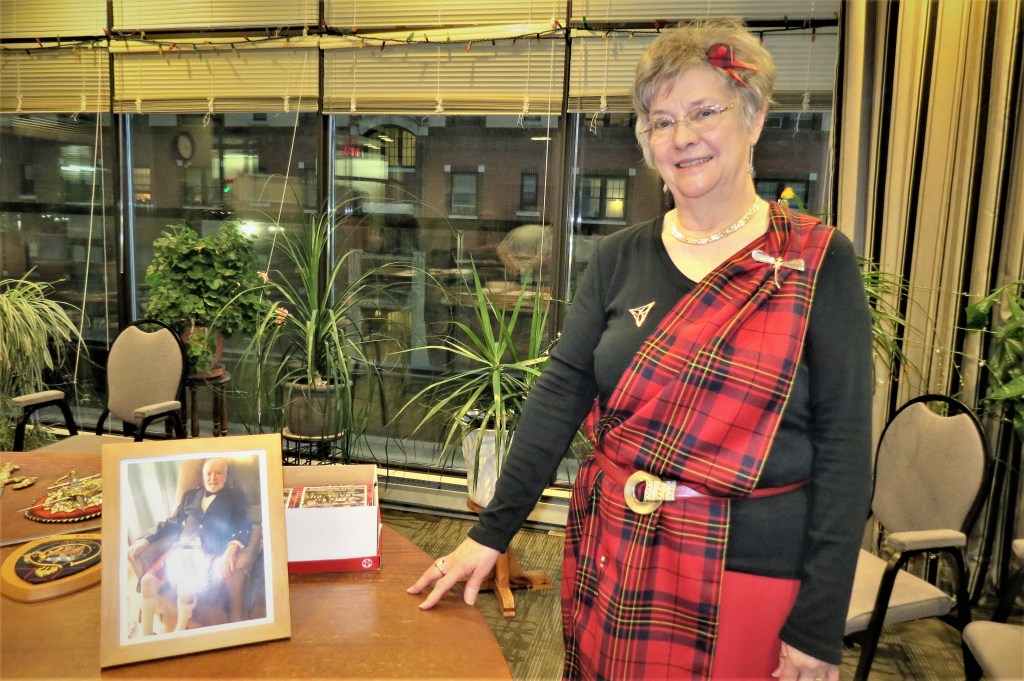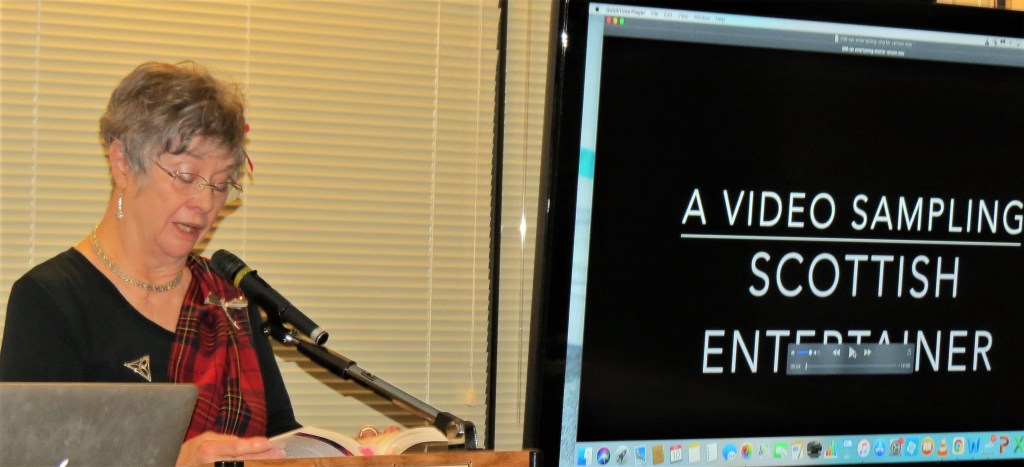
FINALLY: A BOOK LAUNCH!!!! Co-Author/Editor Gayle Moore-Morrans celebrated as she launched Moomor Publishings’ latest book on the Amenities Floor at FRED DOUGLAS PLACE, her seniors’ residence in Winnipeg, on September 10, 2021, almost 11 months after the book had first been published. Due to the restrictions of the pandemic, it had not been possible to have an in-person launch for the book until then. There was a good turnout of residents eager to hear about Gayle’s insights (some of them had already purchased and read the book in months past), an interview of Gayle as co-author/editor, a book signing/sale and a chance to watch a video of Ian reading a story from the book, plus a number of videos of him singing as a Scottish entertainer in years past. More book readings are being planned: A zoom presentation across all five Canadian time zones, sponsored by the Facebook Group LUTHERAN WOMEN CONNECTING on November 6th at 3 p.m. Central Time (plans are to record the presentation for later sharing online) and a live presentation for members of the ROBERT BURNS CLUB OF WINNIPEG on November 20th.



Reviews of Came To Canada, Eh? Adventures of a Scottish Nomad, by Ian Moore-Morrans with Gayle Moore-Morrans
From James Osborne, author of Amazon #1 bestseller, The Ultimate Threat:
“Came to Canada, Eh? is a brilliant and beautifully told story of the journey through life by a newcomer to Canada, at once both candidly disarming and brutally honest. This book is an important contribution to Canadian heritage.”
From Charles H. Cameron CD, Past President, Robert Burns Club of Winnipeg:
“Mr. Ian Moore-Morrans, in my humble opinion, reminds me so much of a Poet/Song writer in Scotland, each travelling the countryside in search of employment and happiness to better his life and that of his family. A paraphrase of Robert Burns’ poem, Rantin’, Rovin’ Robin could aptly describe Ian’s story: “Ian was a rovin’ boy, Rantin’, rovin’, rantin’, rovin’, Ian was a rovin’ boy, Rantin’, rovin’ Ian! He’ll hae misfortunes great an’ sma’, But ay a heart aboon them a’, He’ll be a credit till us a’ —We’ll a’ be proud o’ Ian.”
From Liz Olson, award-winning short story writer, occasional editor/copy editor and former editorial assistant for Canada Lutheran magazine: “Put down that celebrity bio and pick up Came to Canada, Eh? Ian is the real deal, the most relatable Everyman you will ever meet. Circumstances don’t allow for fame or fortune, despite his remarkable gifts, but nothing keeps this guy down for long. His indomitable spirit and quirky humour sustain him through a rollercoaster of adventures and tragedies, and the ride even leads him to a second chance at love at the end of the road. Don’t miss this!
From ARK on amazon.ca, 4 out of 5 stars:
“Never a Dull Moment. Ian’s experience as an immigrant to Canada with the attendant challenges of employment are possibly representative of the challenges faced by many immigrants now, and in times past. Ian’s experiences will likely resonate with immigrants especially, as well as with those who have felt like an ‘outsider’. Ian’s determination in the face of obstacles will be an inspiration to many readers. Very readable and enjoyable chronicle.”
By Amazon customer on amazon.ca: 4 out of 5 stars:
“Ian is a story teller. Reading the book I can hear Ian telling the stories and the book is full of his storied life. There is a chuckle on every page.”
From Pat, a Winnipeg reader and a fellow resident at author’s senior housing. “Dear Gayle, I did enjoy reading Ian’s book “Came To Canada, Eh?” It was a hoot! But I was again struck by his unskeptical and unsuspecting manner as I earlier evidenced in his first memoir “From Poverty to Poverty: A Scotsman Encounters Canada.” As I had indicated, an alternate title might have been – “Innocents Abroad.” However, when I read the Epilogue and noted that Ian had chosen ‘honesty’ as (what he thought) his most important characteristic, it somehow all fell into place! Because he was such a generous, trustworthy person, he trusted others to be as open and honest as himself. What a guy!”
From Editorial Evaluator at Friesen Press prior to publication:
“First off, I found Ian to be an incredibly strong storyteller, very direct, down-to-earth, and relatable. His writing style is straightforward and easy to read, even when “speaking” with the Scottish burr.
More importantly, he truly lived an extraordinary life. Although the individual moves and layoffs, for example, are fairly commonplace, when told en masse, in this sort of personal narrative, I found it incredibly impressive that he managed to maintain his hope and optimism. I can’t imagine that, in his shoes, I would have shown even a fraction of his determination.
Overall, he is a very sympathetic and likable character, even when occasionally coming across as a bit grouchy―and I like the fact that he actually acknowledges this likelihood.
In a personal memoir, unless one is famous, it is very important that the main “character” is compelling, likable, three-dimensional, and flawed. I never got the sense that he was painting himself as a victim or a hero. Instead, it seemed like a very honest retelling of the events that made up his Canadian experience.
I appreciated the way he retained his connection to his Scottish roots, and found it particularly interesting when he felt the need to defend England and Queen Elizabeth from his German colleagues. When combined with the various historical facts that are shared within the narrative, I found it very impressive that he was able to put his natural Scottish biases aside in order to speak to the larger picture.
The inclusion of his essay, “Destroy the Scots: A Brief History of the Peoples of the Highlands of Scotland and their Desperation in Trying to Exist,” really added a great deal of depth and gravitas to the narrative as a whole, and gave the reader a clearer insight into not only a historical period that most non-Scots are unaware of but into his character as well.
His deep roots were clearly a large part of the man he was, and influenced the way he interacted with the world around him, balking at injustice, appreciating practicality, and standing strong against anything that threatened to get in his way.
I very quickly felt like I knew him, and was enjoying following him on his various moves around the country. I also found it sort of refreshing, in an odd way, that he came across so many dishonest, unpleasant Canadians. As an editor, I have evaluated many of these sorts of stories, and in almost all of them, we Canadians are portrayed almost universally as polite, generous, kind, and so on. And on the whole, I think we are. But at times, one starts to wonder at the almost total absence of jerks. I have certainly come across plenty of those in my life, all of them born and raised in Canada. By including these negative representations, I found the story seemed somehow more real and relatable. His love of Canada, and its people are showcased as well, but in a seemingly more realistic way.
With so many changes of setting and scenery, the pace of the narrative was good, always moving forward. It also afforded him the chance to introduce many interesting people, and does an excellent job of keeping them recognizable and individual.
While his writing is generally very simple in style, he also showed a real knack for capturing a moment. For example (from his essay): “Even today, over 250 years later, one can feel an air of mourning that persists in Scotland’s Culloden Moor. No birds sing; no heather grows on the mounds of earth that cover the many mass graves.” One can almost feel the haunted stillness of the place. This is very good writing.
Lastly, the organization is very effective. Largely chronological, and interspersed with pictures, poems, song lyrics, articles, and so on, as well as the lovely eulogy and epilogue. I found the narrative flowed very organically and kept my attention right through to the end, with the elements written by you, Gayle, fitting seamlessly into the story, never detracting or distracting from the rest but actually adding greatly to it.”
The Editor’s Manuscript Evaluation written for Friesen Press before publication: “A sequel to From Poverty to Poverty: A Scotsman Encounters Canada, this story follows Ian Moore-Morrans’ continuing experiences in Canada, endeavouring to survive and thrive in his new country, while facing and overcoming recurring professional and financial setbacks, as various recessions lead to lay-offs and dozens of relocations around Canada―with his wife, children, and pets―in search of new opportunities. Through all the ups and down, he and his family manage to stay positive and hopeful, overcoming the hardships, supporting each other, and always staying open to whatever life has to offer next. This story follows his personal and professional adventures through his retirement, the death of his first wife, and to his second marriage, during which he is finally able to focus his energies on singing, dancing, writing, and basically enjoying his life to its fullest until his passing in 2019.











 Pictured here is the entrance to our tiny apartment in Winnipeg where we will be completing almost a year’s residence by the end of May. This display of three of our published books is our small attempt to advertise our publishing efforts of the past. Getting settled in after our move from British Columbia last summer and re-adjusting to apartment living and a return to a city we left eleven years before, finding time to celebrate being with family and friends we had left behind, plus the daily struggles of adjusting to Ian’s disabilities have taken their toll on keeping up this blog.
Pictured here is the entrance to our tiny apartment in Winnipeg where we will be completing almost a year’s residence by the end of May. This display of three of our published books is our small attempt to advertise our publishing efforts of the past. Getting settled in after our move from British Columbia last summer and re-adjusting to apartment living and a return to a city we left eleven years before, finding time to celebrate being with family and friends we had left behind, plus the daily struggles of adjusting to Ian’s disabilities have taken their toll on keeping up this blog.







